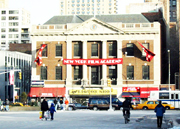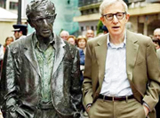
When once thinks movies, they think Hollywood. It is only natural. However, experts have said time and time again that Hollywood is where one finds love for the film industry. If you want love for film, you have to go to New York.
Maybe it's a narcissistic love for a media form that seems enamored with their city, but New Yorkers can't get enough movies. In fact, if you are a believer of the power of watching a movie with the right audience, New York is the place to go.

A lot of people think the know New York because they have seen it in movies. It is not a far-off assumption. So many hundreds and hundreds of movies have portrayed the Big Apple through the decades that one could easily paint a map of the city through time just by naming a few film titles.
But that only accounts for your New York experience. If you want a true cinematographical experience, you can either visit the places that have been turned unforgettable by classic movies. Or you can share a movie experience with New Yorkers. Because you can get movies pretty much anywhere in the world, this is a pastime that has been neglected by most travel guides, who overlook the fact that New York is one of the best places in the world to connect with cinema.
Since the mood created by the audience is a non-demonstrable factor, let's stick to the cold facts. New York's theaters are among the best and more state-of-the-art ones in America.
They are also among the oldest one. The city was swept by the entertainment-mania wave that took over the U.S. in the early 20th century. The world moved from the freaks of P.T. Barnum (the impresario who single-handedly invented American show business thanks to the "museum" he set up in Ann Street, in New York) to more sophisticated sources of entertainment like the Ziegfeld follies, Broadway shows and other genres that have defined the culture of our present times.

These two forms of entertainment, both variations of theater, would die a quick death when cinema came along. Moving images immediately gripped audiences of all classes and of all origins, so that the majestically palatial houses that had been built to put on spectacular shows were transformed into movie theaters that had all the care and all the love of vintage constructions. Just going to them was part of the cinematic experience. What new theaters were built for this lucrative market had to compete this these buildings, so they were just as amazing if not more. This is when New York, world capital of entertainment for years now, also became world capital of movies.
Then came the 1960s and the advent of television changed everything. The small screen (which ironically had been introduced to the world in New York, in the 1939 World Fair that had been located on Queens) offered the public with the thrill of moving images with the advantage of immediacy, and it was free. It could not, however, compete with movies in terms of spectacle. Inventions like CinemaScope, 3-D and other gimmicks were shoehorned into Hollywood mainstream productions and New York theaters had to put up with expensive renovations to show them like no-one else.
Not all cinema tried to compete with television, though. After all, TV is TV and movies and movies. Some filmmakers reclaimed their right to exist based solely on their cinematic value. That's when the arthouse movement began to take form. It didn't need such expensive renovations. Their content would suffice.
The arthouse movement was, and is, defined by their divorce from the industry. Since this industry is mainly located in Hollywood, there was barely any room for the indie movement over there. The foreign-movie, small-budget, arthouse circuit began to develop with the much more heterogeneous streets of New York, where it was sure to have an audience.
Both tendencies, mainstream and arthouse, have co-existed in New York much more happily than in any other state. Perhaps more than any other city in the world. To this day, it remains